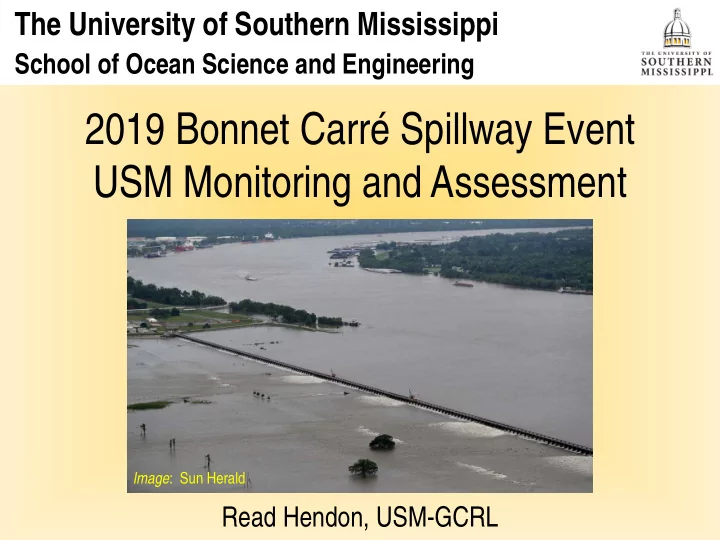

The University of Southern Mississippi School of Ocean Science and Engineering 2019 Bonnet Carré Spillway Event USM Monitoring and Assessment Image : Sun Herald Read Hendon, USM-GCRL
Bonnet Carré Spillway General purpose is to reduce Mississippi River level, control flow rate, and minimize down-river flooding. Designed and constructed in response to Great Flood of 1927 Construction completed in 1931; first opening in 1937 Source : http://www.mvn.usace.army.mil/Missions/Mississippi-River-Flood-Control/Bonnet-Carre-Spillway-Overview/Spillway-Operation-Information/
Bonnet Carré Spillway - 2019 Most number of days open in single year (123 d) First time opened twice in the same year First time opened in consecutive years Days Open - 1st Opening Days Open - 2nd Opening 125 First 70 Years = Past 12 Years = 8 Openings 6 Openings 100 Number of Days Open 75 50 25 0 1937 1945 1950 1973 1975 1979 1983 1997 2008 2011 2016 2018 2019 Year of Opening 2019 Discharge = 1.35 trillion cubic feet (15,000,000+ Olympic pools) Data Source : http://www.mvn.usace.army.mil/Missions/Mississippi-River-Flood-Control/Bonnet-Carre-Spillway-Overview/Spillway-Operation-Information/
Bonnet Carré Spillway - MDMR Marine Resources Monitoring and Assessment
Bonnet Carré Spillway - USM Expanded Monitoring and Assessment Water Quality Remote Sensing and Modeling Oyster Spat Settlement Archive of weekly updates available on USM-GCRL website: http://gcrl.usm.edu/news/2019.bonnet.carre.spillway.overview.php
Bonnet Carré Spillway - USM Water Quality nutrients concentrations chlorophyll- a source water identification suspended particulates phytoplankton community bacteriology Remote Sensing and Circulation Modeling – understand dynamics and extent of the spillway discharge Biological Resources – oyster spat settlement
USM Field Sampling Outputs OCEAN PASCAGOULA BILOXI GULFPORT SPRINGS BAY ST. LOUS OCEAN PASCAGOULA BILOXI GULFPORT SPRINGS BAY ST. LOUS Complete closure of spillway = July 27 Depiction of surface salinity levels in the Mississippi Sound for July 17 (top) and August 22 (bottom), as extrapolated from field data at expanded water quality stations (yellow squares).
USM Field Sampling Outputs OCEAN PASCAGOULA BILOXI GULFPORT SPRINGS BAY ST. LOUS OCEAN PASCAGOULA BILOXI GULFPORT SPRINGS BAY ST. LOUS Complete closure of spillway = July 27 Depiction of bottom salinity levels in the Mississippi Sound for July 17 (top) and August 22 (bottom), as extrapolated from field data at expanded water quality stations (yellow squares).
USM Field Sampling Outputs Source Water Tracking 13-14 August 2019 25 July 2019 % MR in Total % MR in FW Preliminary results from July 25 (left) and August 13-14 (right) sampling to determine sources of freshwater in the Mississippi Sound, based on isotopic signatures. Top panels depict the percentage of all water in the sample assigned to the Mississippi River. • Bottom panels depict the percentage of freshwater in the sample assigned to the Mississippi River. • Complete closure of spillway = July 27
USM Coastal-Ocean Modeling Regional surface salinity model output for July 16 (left) and August 15 (below). Warmer colors (yellow to red) represent higher salinity waters typically observed in the region, while cooler colors (blue) are representative of lower salinity waters. Complete closure of spillway = July 27
USM Discharge Monitoring MAY 2018 MAY 2019 • Particulate backscattering from satellite ocean color data indicating suspended particulate matter in the water column • White areas indicate data gaps as a result of cloud cover
USM Sampling Oyster Spat Assessment Monitor and quantify recruitment of oyster larvae
Recommend
More recommend